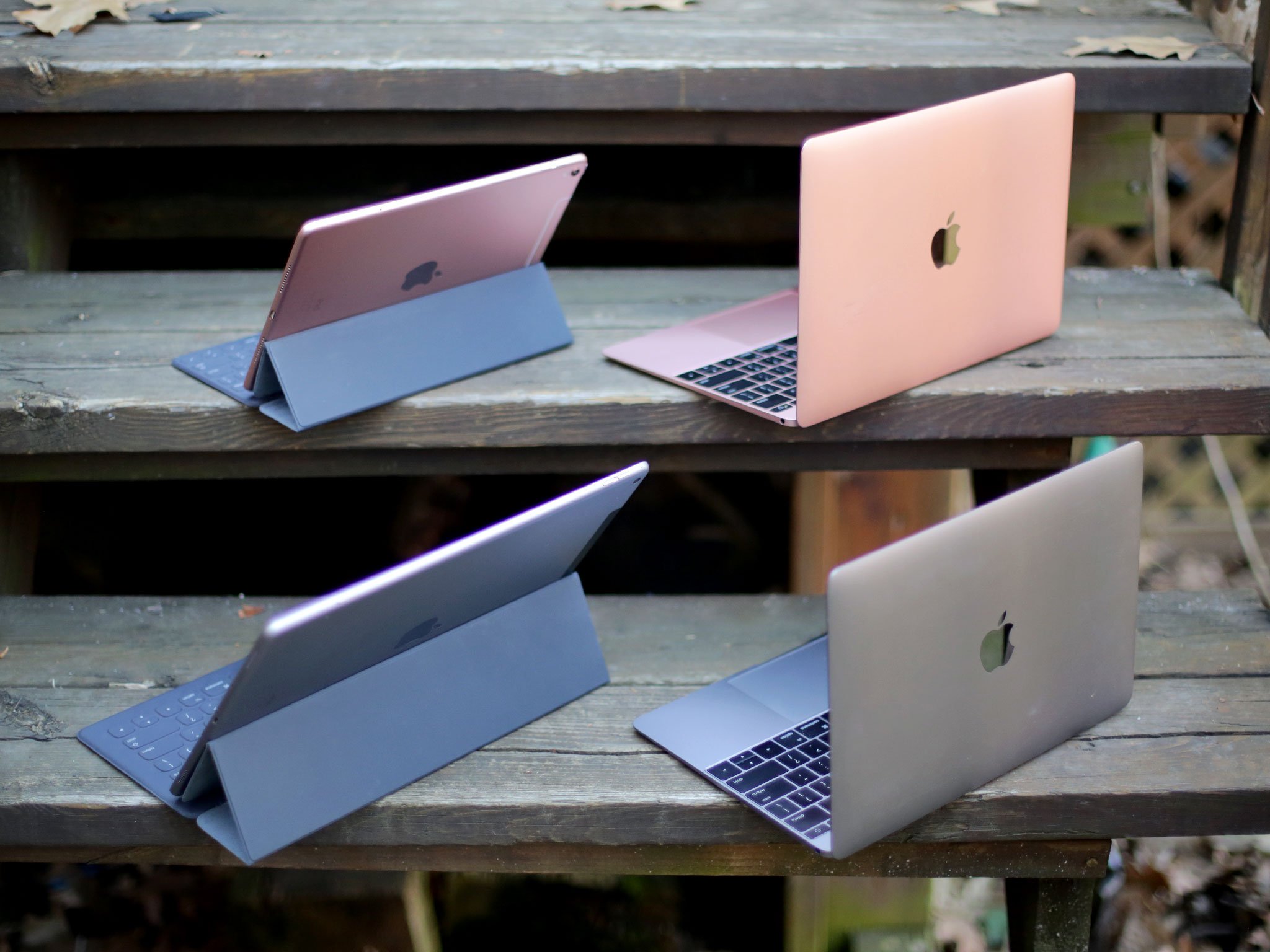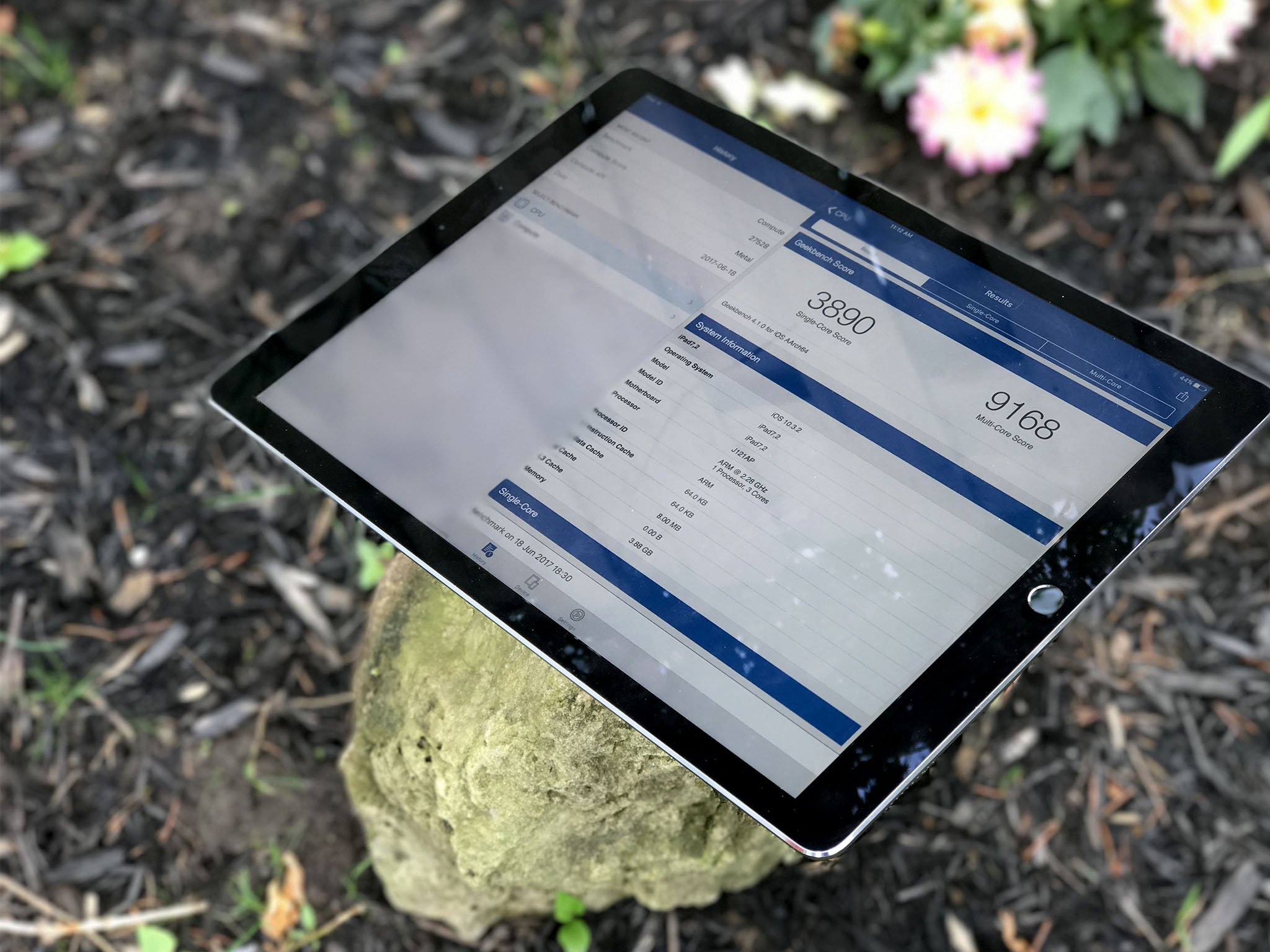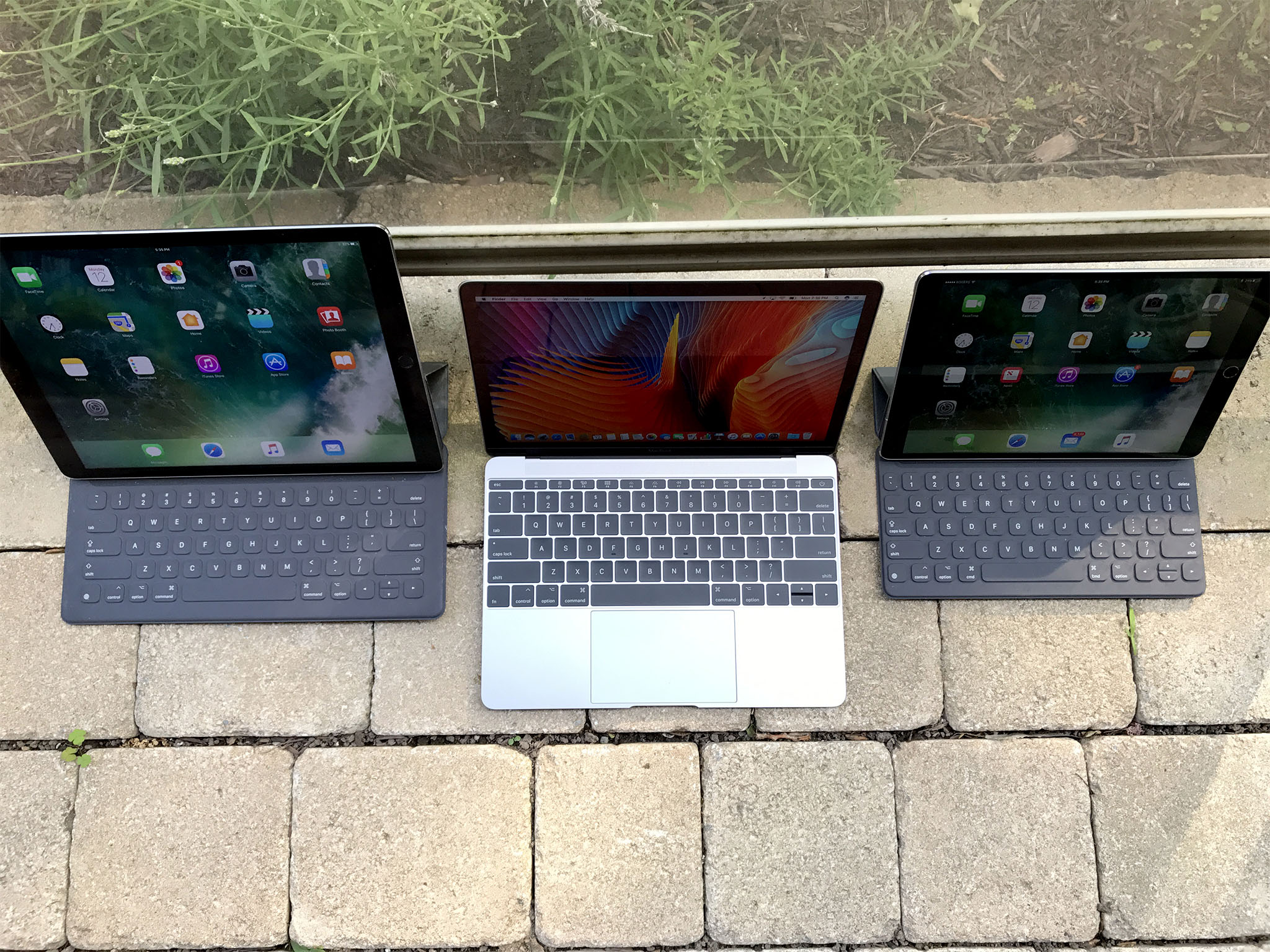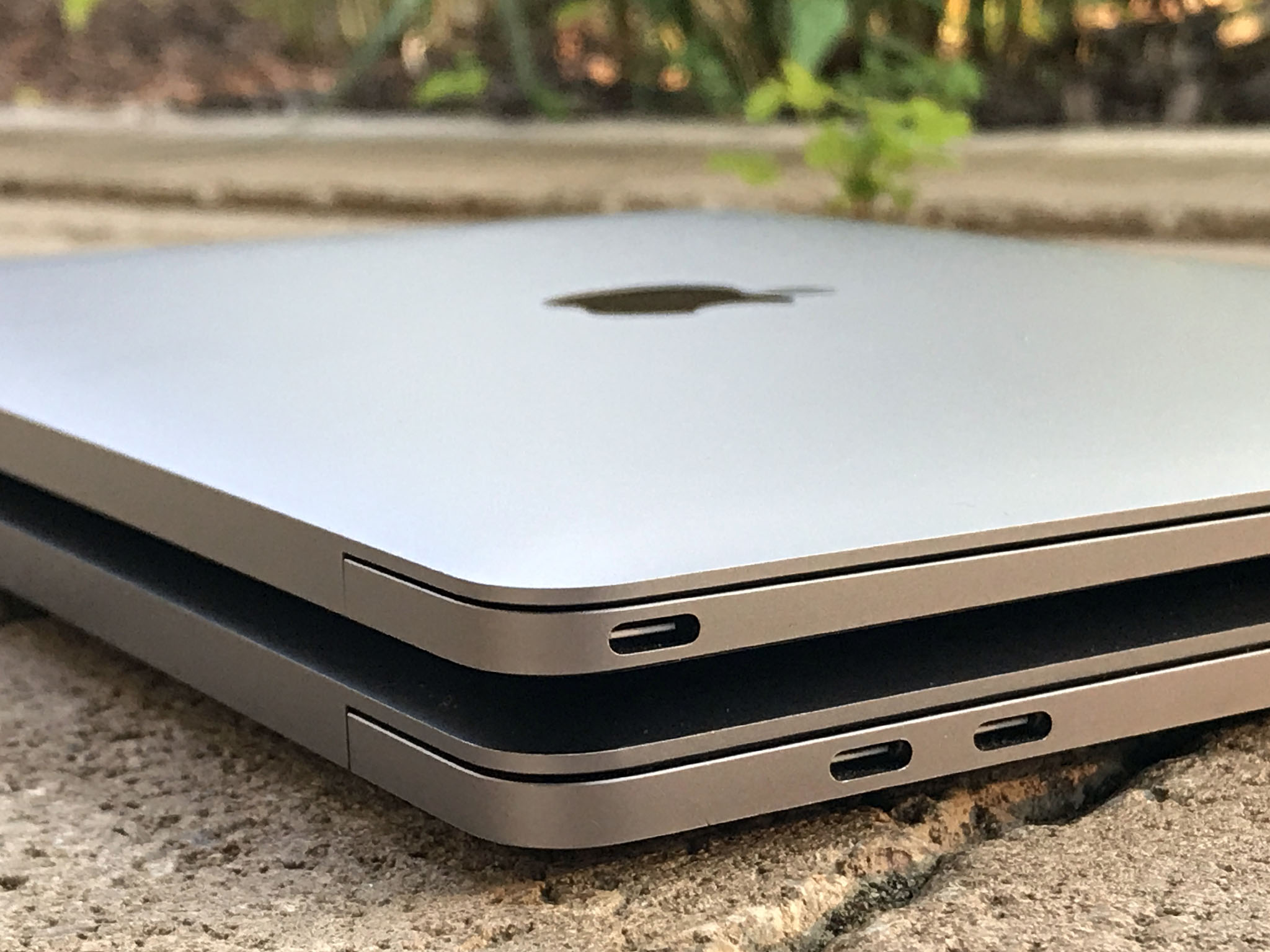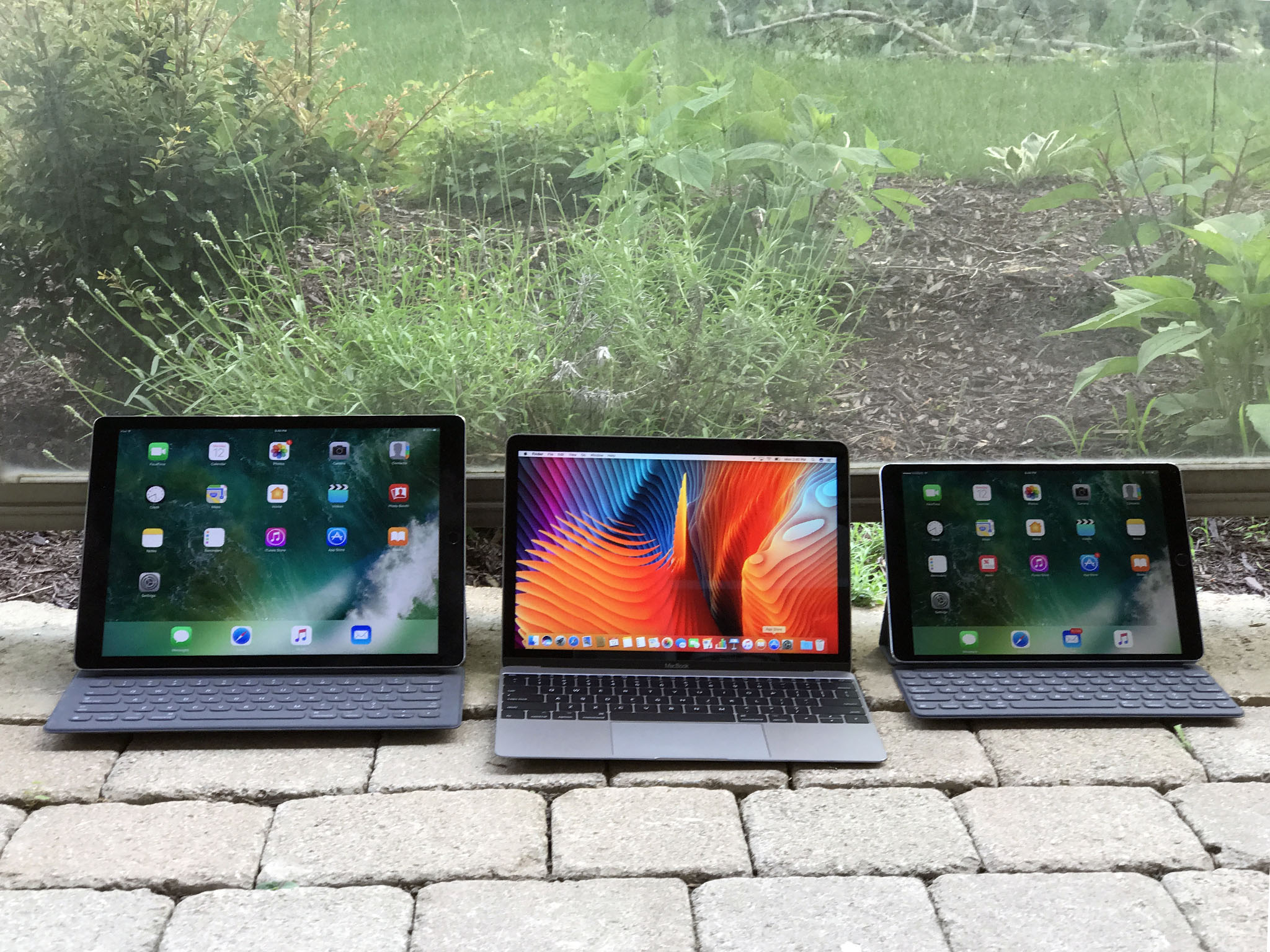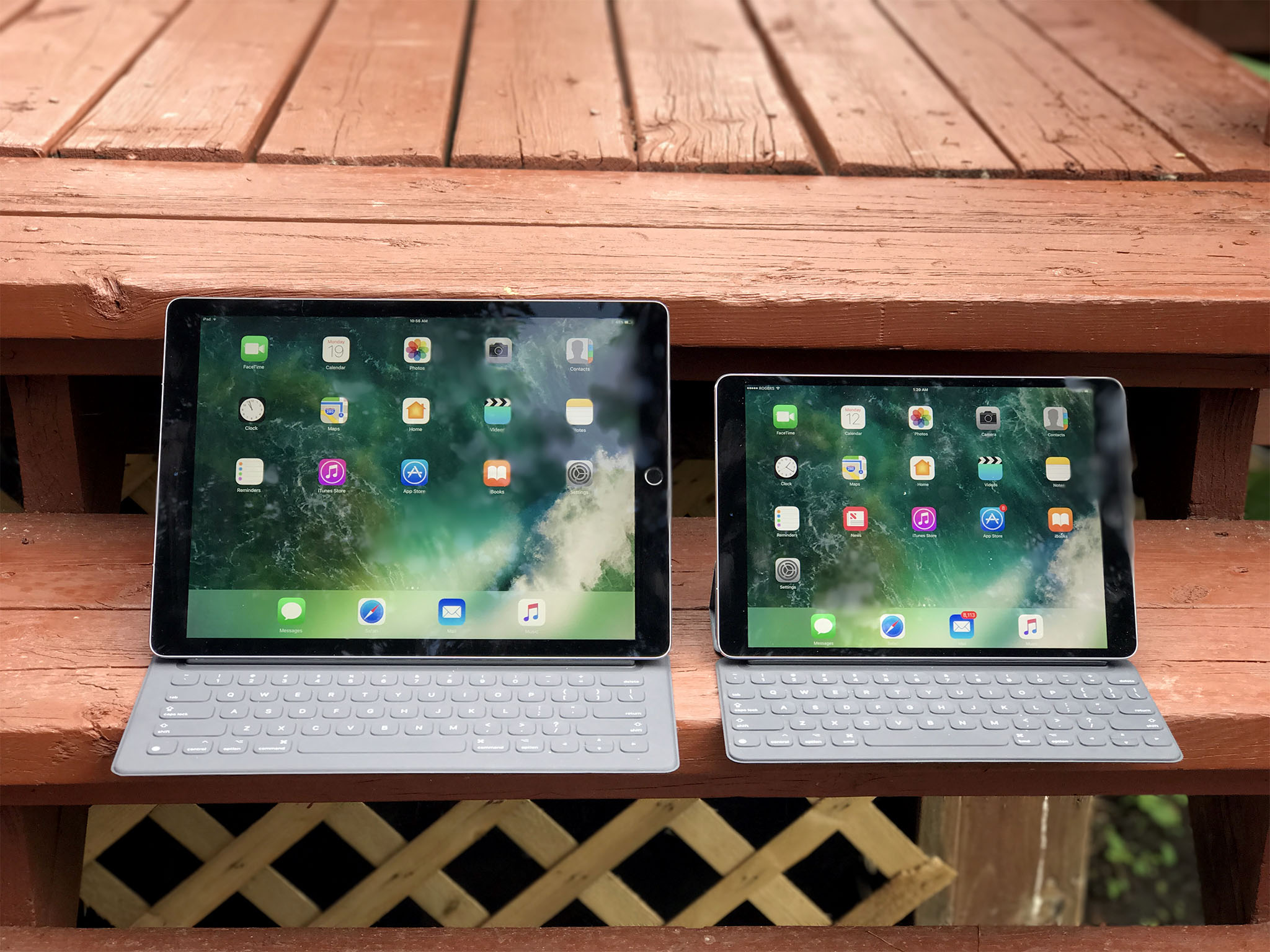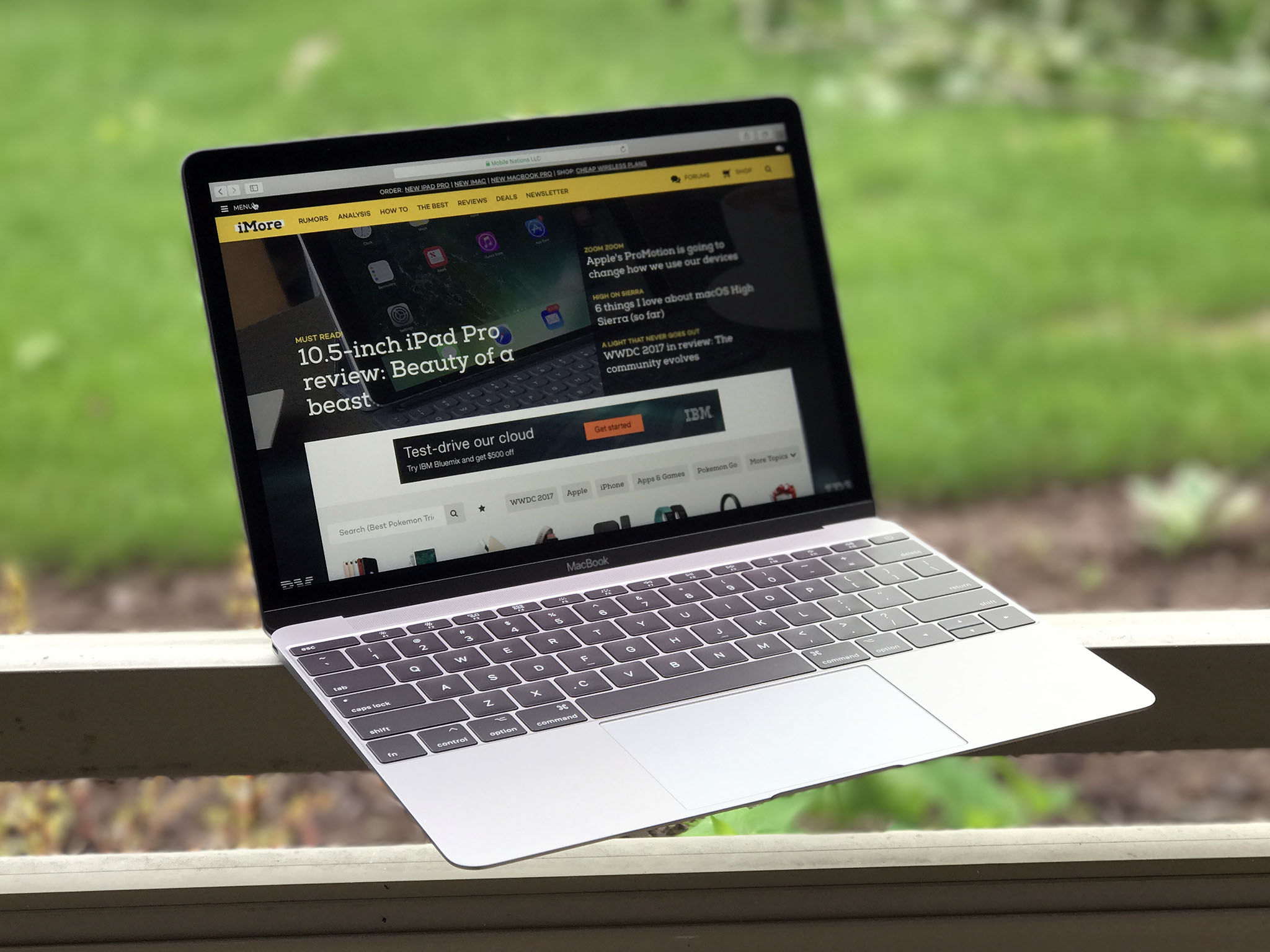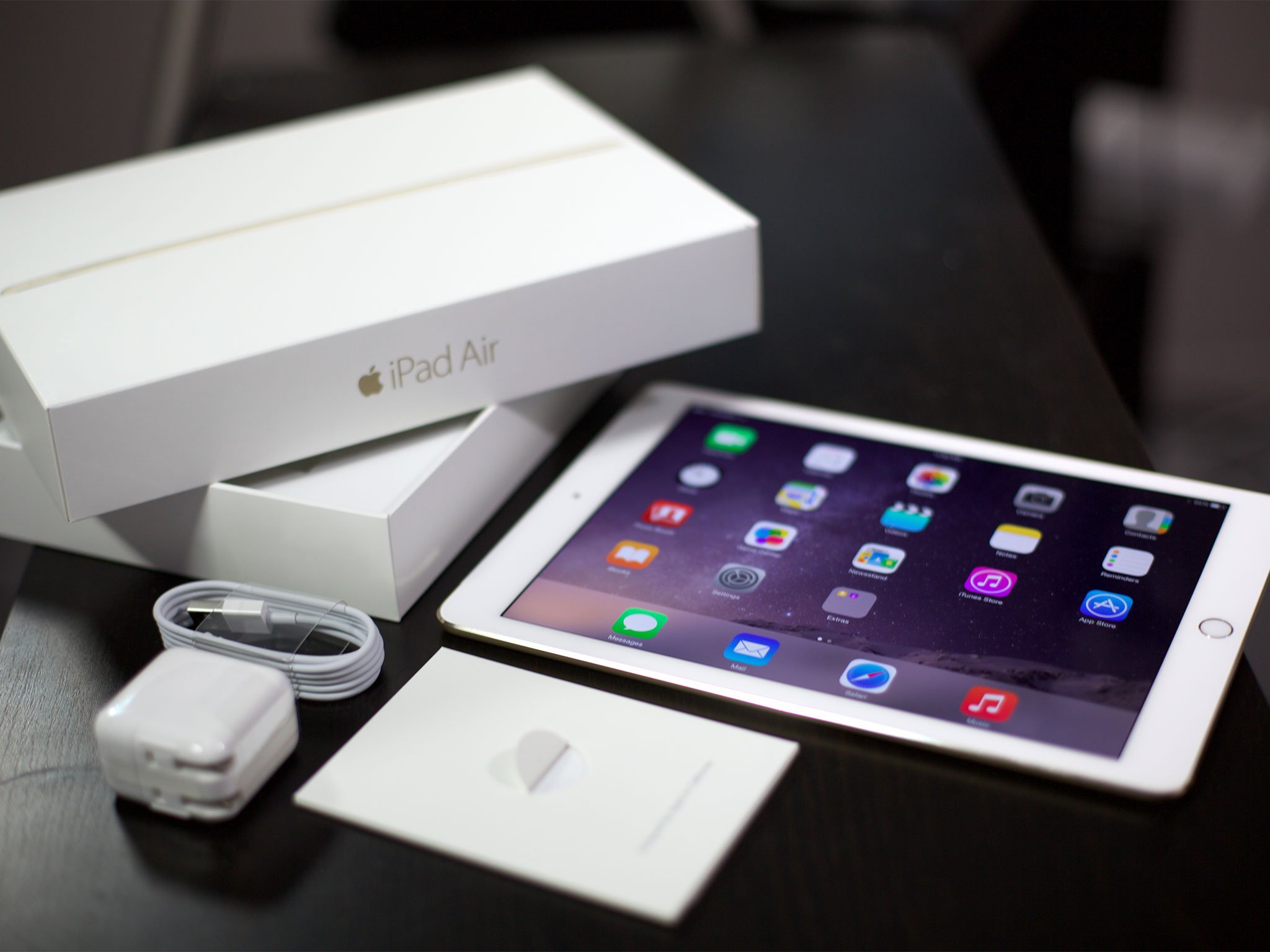iPad and iPad Pro vs. MacBook and MacBook Pro: Which should you buy?
- apr
- 23
- Posted by Michael
- Posted in Okategoriserade
Deciding between a MacBook or iPad? Here's the breakdown you didn't know you needed.
Pundits have gone round and round debating the merits of iPad as computer or computer as potential touch tablet, but here's the honest truth: Both can be equally powerful options for very, very different tasks.
As much fun as it would be to ring up another round in the heavyweight battle that is iPad versus Mac, I say we call the whole thing off. Instead, let's focus on what actually matters: tailoring the tasks you need to accomplish with the computer that makes sense for those tasks.
The iPad and iPad Pro can be an incredible device for artists, those that need a portable cellular connection, or extreme portability. In contrast, the MacBook (and by extension, MacBook Pro) laptops are perfect for those who need a super-charged multitasking machine, a compact Mac, or a permanent keyboard solution. Both can be ideal on planes, in coffeeshops, studying in classrooms, presenting in boardrooms, and relaxing in living rooms.
But which one is ideal for you?
- Specs
- Price
- Size and display
- Processor and battery life
- Touch vs. keyboard and mouse
- Ports and expansion
- The operating system
- Apps and services
- Who should get an iPad?
- Who should get a MacBook?
Check our reviews
We'll chiefly be exploring iPad vs. MacBook here, but if you want to go really in-depth with them, we have some comprehensive reviews for you!
Specs showdown
At first glance, iPad vs MacBook might seem like an odd comparison, especially at the specifications level. But there's a lot here to compare and contrast. We'll be diving deep into how these tablets and laptops stack up, but if you want the specs, here they are.
| Category | iPad | iPad Pro | MacBook | MacBook Pro |
|---|---|---|---|---|
| OS | iOS | iOS | macOS | macOS |
| Screen Size | 9.7 inches | 10.5: 10.5 inches 12.9: 12.9 inches |
12 inches | 13: 13 inches 15: 15 inches |
| Screen Type | LED Multi-Touch | LED Multi-Touch | LED IPS | LED IPS |
| Resolution | 9.7: 2048x1536 | 10.5: 2224x1668 12.9: 2732x2048 |
2304x1440 | 13: 2560x1600 15: 2880x1800 |
| Pixel Density | 264 ppi | 264ppi | 226ppi | 13: 227ppi 15: 220ppi |
| Processor | Apple A10 | Apple A10X | 1.2GHz Intel Core m3 to 1.3Ghz Core i5 | 13: 2.3-3.1GHz Intel Core i5 to 15: 2.8-2.9Ghz Core i7 |
| RAM | 2GB | 4GB | 8-16GB | 13: 8GB 15: 16GB |
| Storage | 32GB-128GB | 64-512GB | 256-512GB | 13: 128-512GB SSD 15: 256GB-2TB SSD |
| Connectivity | Wi-Fi 802.11ac, Bluetooth 4.2, Lightning Port | Wi-Fi 802.11ac, Bluetooth 4.2, Lightning Port, Smart Connector, optional LTE-A | Wi-Fi 802.11ac, Bluetooth 4.2, USB-C port | Wi-Fi 802.11ac, 4x USB-C/Thunderbolt 3 ports | Wi-Fi 802.11ac, 4x USB-C/Thunderbolt 3 ports |
| Battery | 9.7: 32.4Wh, up to 10 hours | 10.5: 30.4Wh, up to 10 hours 12.9: 41Wh, up to 10 hours |
41.4Wh, up to 10 hours | 13: 49.2Wh, up to 10 hours 15: 76Wh, up to 10 hours |
| Dimensions | 9.7: 9.4 x 6.6 x 0.29 inches | 10.5: 9.8 x 6.8 x 0.24 inches (251 x 174 x 6.1 mm) 12.9: 12.0 x 8.7 x 0.27 inches (306 x 221 x 6.9 mm) |
11.0 x 7.7 x 0.52 inches (280 x 197 x 13.1 mm) |
13: 12.0 x 8.4 x 0.59 inches (304 x 212 x 14.9 mm) 15: 13.8 x 9.4 x 0.61 inches (349 x 240 x 15.5 mm) |
| Weight | 9.7: 1.03 lbs (469 g) | 10.5: 1.03 lbs (469 g) 12.9: 1.49 lbs (677 g) |
2.03 lbs (920 g) | 13: 3.02 lbs (1370 g) 15: 4.02 lbs (1830 g) |
| Colors | Space Gray, Gold, Silver | Space Gray, Gold, Rose Gold (10.5 only), Silver | Space Gray, Gold, Rose Gold, Silver | Space Gray, Silver |
| Price | 9.7: $329 - $559 | 10.5: $649 - $1129 12.9: $799 - $1279 |
$1299 - $1949 | 13: $1299 - $2899 15: $2399 - $4199 |
Price
Before you get into feature comparisons, it's important to consider your budget.
iPad & iPad Pro
The base-model $329 iPad is the cheapest computing device Apple sells, but it comes with only 32GB of storage. If you're considering this iPad, you're probably going to want to upgrade to 128GB and buy some accessories like the Apple Pencil and possibly a Bluetooth keyboard. Together, that's going to run you closer to $600 — and a bit more if you're considering picking up the cellular model.
That said, the higher-end iPad Pro will run you anywhere from $649 to $1229 without any accessories like the $129 Smart Keyboard or $99 Apple Pencil or AppleCare.
MacBook & MacBook Pro
The MacBook and MacBook Pro both start at $1299 and can be configured all the way up to $4199; they also offer more out-of-the-box hardware features (like a keyboard and trackpad).
Bottom Line
If cost is a bigger issue for you than a computer's specific features, the 9.7-inch iPad offers the most cost-effective entry point into the mobile computing space. Even if you need to purchase a physical keyboard and Pencil on the base model iPad, you'll still only spend around $600 to the MacBook Pro's entry-level $1299 price point.
Size and Display
Apple sells the iPad in three* main sizes (9.7, 10.5, and 12.9", all with 4:3 aspect ratios), and the MacBook and MacBook Pro in three (12", 13", and 15", with 16:10 aspect ratios). What size and screen type makes the most sense for you? Read on.
*Yes, there is a fourth iPad model in Apple's line, the 7.9-inch iPad mini, but we don't currently consider it a potential stand-alone computer replacement for a number of reasons.
iPad & iPad Pro
The base-model iPad's 9.7-inch Retina display is 2048x1536. Unlike the iPad Pro's 10.9-inch and 12.9-inch displays, the 9.7-inch iPad has no lamination on its display, no P3 color space, no ProMotion, and no TrueTone display. It's still a solid option, but it comes without many of the perks found in the higher-end models.
Speaking of those higher-end models: The 10.5-inch iPad Pro P3 Wide Color display comes in at 2224x1668 at 264 pixels per inch (PPI), while the 12.9-inch is 2732x2048 (also 264 PPI).
The 12-inch model is the largest iOS display Apple has ever shipped: While it's not quite as dense in pixels as iPad mini or iPhone 7 Plus, iPads are designed to be held further away than your smartphone, making the screens look roughly equal to the average eye.
Both iPad Pro displays sport Apple's ProMotion technology, which offers a variable refresh rate of up to 120Hz; this is especially great for anyone who needs fast touch response or low-latency art or writing work. They also take advantage of True Tone, which adjusts the iPad's color temperature to match ambient light, making it look paper-white.
MacBook & MacBook Pro
The MacBook's 12-inch Retina display offers a 2304x1440 resolution at 226 PPI, slightly less dense than the iPad Pro's 12-inch 4:3 screen. It lacks both ProMotion, True Tone, and the P3 color space.
The MacBook Pro's 13- and 15-inch displays are a little more advanced: They sport 2560x1600 and 2880x1800 displays at 227 PPI and 220 PPI, respectively; they're also brighter than the MacBook (with a maximum brightness of 500 nits), and support P3 Wide color.
Bottom Line
If it's size and display quality that matters to you, the 10.5-inch iPad Pro is the best "small" computer Apple has ever made. It packs an overwhelming amount of features into a compact and portable size. If your desk or backpack can withstand a larger machine, the 12.9-inch iPad Pro is a tad bit larger than the 12-inch MacBook, while the 13-inch MacBook Pro is larger than both (and the 15-inch the biggest of the group). In total, the devices range from 1.03 pounds (10.5-inch iPad Pro, Wi-Fi-only) to 4.02 pounds (15-inch MacBook Pro).
When it comes to displays, Apple has infused the iPad Pro with the latest and greatest technology it possesses. That's not to discount the beauty of the base iPad or MacBook's Retina screens; they're still beautiful pieces of kit. But if you're doing any sort of graphics work, you'll want to consider an iPad Pro or MacBook Pro for the P3 color space alone. Add in a predisposition to gaming, reading, or drawing, and the iPad Pro's ProMotion technology far outpaces Apple's base iPad and laptop line.
Processor power and battery life
The base iPad runs off an Apple A10 64-bit SOC (system on a chip), along with an M10 co-processor and 2GB of RAM; the iPad Pro supercharges that with an A10X processor and 4GB of RAM. In contrast, the company's Mac line uses Intel processors with the Core m3, i5, and i7 found in the MacBook and i7 in the MacBook Pro; they have 8-16GB of RAM, respectively.
All three of Apple's portable lines claim 10 hours' battery life — though some tasks inevitably require more power than others.
iPad Pro
The iPad Pro line is one of the first to feature processors that outpace modern Macs, with iMore's Geekbench tests showing single-core speeds coming in at 3935 and multi-core tests at 9299. That's thanks to Apple's A10X Fusion chip, 4GB of RAM, and M10 co-processor — it's a powerhouse package that makes everyday tasks whiz by. The 9.7-inch iPad received a slightly less powerful (but still respectable) 3254 single-core score and 5857 for multi-core.
On the battery side, the iPad offers a 32.4-watt-hour battery, while the iPad Pro models have a 30.4-watt-hour (10.5-inch) and 41-watt-hour (12.9-inch) battery, respectively; the difference in battery size is due to the extra power drain when running the 12.9-inch model's larger screen, so that all sizes can sport 10 hours of battery life.
MacBook & MacBook Pro
The MacBook and MacBook Pro lines aren't slouching when it comes to power: They both run on Intel's Kaby Lake chipset, which optimizes performance while providing great battery life and also provides hardware support for H.265/HEVC (coming to High Sierra later this fall).
The MacBook uses Kaby Lake-Y, an ultra-low-power version of the standard Intel Kaby Lake processors, so that Apple can keep the laptop's slim form factor without setting fire to your lap. The MacBook starts with a 1.2Ghz dual-core Intel Core m3, though you can choose optional upgrades to boost that up to a 1.4GHz dual-core Intel Core i7. Its base-model speeds come in slightly below the 2017 iPad Pro, with iMore's Geekbench tests reporting 3317 for single-core and 6738 for multi-core benchmarks.
Apple's larger laptops run Kaby Lake in its full-powered form, starting with a 2.3GHz dual-core Intel Core i5 baseline for the 13-inch, and 2.8Ghz quad-core Intel Core i7 for the 15-inch. Depending on whether you choose 13-inch, 13-inch with Touch Bar, or 15, you can upgrade these chips to a 2.5Ghz dual-core i7, 3.5GHz dual-core Intel Core i7, or 3.1GHz quad-core Intel Core i7. In English: Even the slowest of these are powerhouse chips. The MacBook Pro is designed to be a portable pro workstation, and Apple has equipped the laptop line accordingly.
Battery life for all three is benchmarked at a respectable 10 hours for Wi-Fi browsing, though power users may see a reduced number — I routinely get 6 to 7 hours out of my 13-inch MacBook Pro, but I also run something like 20 open apps simultaneously, at almost-max brightness.
Bottom Line
The cheapest iPad Pro is more powerful than the entry-level MacBook. This isn't just a figure of speech anymore: It's reality. It can run professional graphics editing programs like Affinity Photo without a hitch; in contrast, the MacBook can be made to stutter when opening a many-layered Photoshop document.
That's not to say the MacBook is completely outclassed: It's an excellent Mac laptop for basic browsing, email, and writing. But if you need a more powerful base-model computer rather than traditional word processing tasks, the iPad is that device.
When it comes to pro-level power, the iPad hangs in the race with the MacBook Pro for a surprising number of tasks — including image rendering — but Apple's top-tier laptop is still the king of multitasking pros.
Battery life, on paper, is very similar between all three computers, but I give an ever-so-slight edge to the iPad and iPad Pro here: Apple's power management is second to none, and — for all of its frustrations — iOS's multitasking limitations and frozen background apps ensure that you're not accidentally burning battery.
Multitouch & Pen vs Mouse and Keyboard
Here's where the decision gets more personal: How do you like to interact with your computer? The iPad and iPad Pro's multitouch and pen interface has a wildly different feel to that of a traditional laptop, and it's arguably designed for different tasks than your average Mac.
iPad & iPad Pro
You interact primarily with an iPad through its multitouch display. You can tap, swipe, pinch, and otherwise gesture your way though the entire operating system and all of its apps, with a virtual, predictive keyboard when it comes to text entry. This opens up a slew of additional touch-based shortcuts for both the operating system and third-party apps, but it comes at the expense of having the traditional mouse-and-pointer input.
You can augment your iPad or iPad Pro with an external physical keyboard — a must for anyone who relies on text entry — and the Apple Pencil, the company's drawing and writing stylus. If you plan to do any handwriting or drawing, the Pencil is a must-have: It's one of the best stylus options on the market, and works flawlessly with the iPad and iPad Pro.
MacBook & MacBook Pro
The MacBook and MacBook Pro both take after laptops past, with a trackpad and physical keyboard, though each offers specific twists on the genre.
The MacBook and entry-level MacBook Pro offer a Force Touch trackpad with support for Force Click and gestures, allowing for more subtle and powerful interactions; they also sport a built-in full-size keyboard with new butterfly switch-style keys.
Upgrade to the MacBook Pro with Touch Bar, however, and you'll get the equivalent of a tiny multitouch iOS display where your hardware function keys once lived. These virtual function keys adjust and change depending on the app you're in and your personal preferences, offering you dynamically changing options for tab switching, autocorrect, frequently used app commands, and more.
Bottom Line
While each input has its own pros and cons, I find that this is largely a personal preference. Do you feel like you can get the majority of your work done on a multitouch device without a mouse and pointer? (Conversely, will you be able to do all your work without the benefit of directly manipulating your canvas or drawing on it?) It's an answer only you can find.
Or, to quote iMore Editor-in-Chief Rene Ritchie:
You can add a keyboard to the iPad Pro and get close to a MacBook experience. You can't add a capacitive display to the MacBook.
Ports and expansion
Both the MacBook and iPad are one-port devices. The MacBook features a single USB-C port for charging and peripheral connection, while the iPad uses Lightning for power and accessories. In contrast, the MacBook Pro offers an array of 2-4 USB-C ports, depending on the model.
iPad & iPad Pro
Though the number of uses for it has grown, both the iPad and iPad Pro still ship with a single proprietary Lightning connector. With it, you can use adapters (sold separately) to interface with non-powered USB devices — principally cameras and SD cards — to retrieve photos, connect to microphones, and more. It can also connect to VGA and HDMI displays.
Technically, the iPad Pro line has a "second" port: the Smart Connector, which provides power to dockable accessories. But because that category currently just includes keyboards and power docks, I'm less inclined to call it a true port so much as a proprietary charging solution for accessories.
Also along those lines, we're not counting the headphone jack as a true port, either. (Sorry, headphone jack lovers.)
MacBook & MacBook Pro
The MacBook is also a one-port device. But unlike the iPad Pro, the Mac makes it simpler to use third-party peripherals — with only one port, that ability was vastly reduced (and sprung a veritable fountain of jokes about adapters as a result). Even with only a single USB-C port, however, you can still do a lot with the MacBook — but yes, you will need an adapter (or hub) to work with older USB devices and accessories.
The MacBook Pro addresses this issue somewhat by providing 2 USB-C/Thunderbolt 3 ports on its base model; 4 ports on every Touch Bar model. You'll still need adapters for older USB devices, but you aren't limited in your adapter use by needing a charge.
Bottom Line
Peripherals and accessories are where the Mac has long shined, and this contest is no different. While you can do a lot with an iPad Pro, if you need the flexibility multiple ports provide — and no restrictions on the type of accessories you can use in said ports — you'll want a MacBook or MacBook Pro.
The operating system
This is the sticking point for most iPad vs Mac decisions: Which is better for getting my work done — iOS or macOS? The answer depends on a number of factors, and as with interfacing, it's a highly personal decision.
iPad & iPad Pro
All iPads ship with iOS 11, Apple's latest mobile operating system. iOS has become increasingly advanced for iPad users over the years, and iOS 11 is no different. It brings an full-featured multitasking system to the tablet, offering drag and drop, multiple window interactions, and an instantly-accessible Dock.
The A10 and A10X processor, when combined with iOS and graphics framework Metal, also lets third-party developers to build even more complex apps for iPad users — including AR experiences. In the past, the iPad has been dinged for its apps being less powerful or complex than their Mac counterparts; that statement is increasingly no longer true.
MacBook & MacBook Pro
The MacBook and MacBook Pro both run Apple's latest laptop and desktop operating system, macOS High Sierra. It's a multi-user, multi-window operating system that combines the power of a traditional UNIX environment with a full-on graphical user interface.
The Mac is powerful and flexible as a result, but that flexibility can mean less focus within single apps; macOS is also entirely built around the keyboard and mouse interface; working with a stylus requires an external tablet solution (or being really good at painting with your fingers on the Force Touch trackpad).
Bottom Line
iOS may have started life off as the "simple" operating system, but it's evolved in such a way that millions of people now work directly on an iPad. If the software you need is available on the App Store, it's easier than ever to spend your work or school day with a multitouch device.
That said, there's a reason why macOS has been long-favored by professionals: Its multitasking workflows and powerful third-party programs allow those comfortable with a keyboard and mouse interface to work and study the way they always have. Coding professionals, too, will likely favor the Mac for programs like Xcode (which aren't available at all on the Mac). If you need advanced multitasking options and software that's not available on the iOS App Store, the Mac is the route to take.
Software availability and services
Apple offers a variety of services for both its iPad and Mac users, including app stores, cloud backup, music subscription, and more.
iPad & iPad Pro
While both iPad and Mac have an Apple-run App Store, the iPad cannot even consider running non-App Store apps unless they've been directly shared through an enterprise program — they must be sandboxed and fit Apple guidelines for security and performance reasons. That hasn't reduced the availability or quality of apps, however: iPad users can download millions of apps for their devices, including productivity software, games, apps for creative professionals, and more. It increasingly contains modern takes on classic apps like Microsoft Office, Affinity Photo, Adobe Lightroom, Coda, and Pixelmator, as well as unique apps all its own, like Procreate and Adobe Comp.
The iPad also hooks into Apple's free iCloud service, which provides users with wireless sync to all your Apple products; you can pay additional fees to back up your photos, subscribe to Apple Music, and more.
MacBook & MacBook Pro
I mentioned Apple's Mac App Store above — it works similarly to the iOS App Store and provides secure access to all kinds of games, productivity, communications, and entertainment apps. You're not restricted to playing in this sandbox, however; you can also download apps from the web, other app stores like Steam, or your favorite developers. This includes desktop-class apps unavailable to iOS, like Xcode, Final Cut Pro X, Adobe Creative Cloud, and many more.
Requisite security note: Only download apps from developers you recognize, and never open unknown files or app types.
Like the iPad Pro, all Macs come with iCloud support baked into their operating system.
Bottom Line
On the software and services side, it comes down to the apps you need to run for your school or work career. There are a ton of great programs out there for both iOS and macOS, but the Mac does edge out in front when it comes to boutique software — especially finance- or office-related. Conversely, iOS has seen the most innovation in graphics work, especially with the introduction of the Apple Pencil as an input tool; users planning to draw or sketch should seriously consider the iPad over a Mac.
Who should get an iPad or iPad Pro?
The iPad isn't your average laptop, and it's all the better for it. As a multitouch-first computer, it can help people for whom traditional computers have always been inaccessible, intimidating, or otherwise off-putting. Its hardware keyboard accessories provide the option for more traditional text input, but it's not required — only provided if you need it.
The tablet is not only as powerful as many laptops, it can empower more people to get more out of it, thanks to the directness of its interface and simplicity of its operations. For graphics professionals and students, the iPad can be an even more powerful purchase thanks to the Apple Pencil, eliminating the need for digital design tablets and spiral-bound notebooks.
Not sure which tablet to buy? Check out our iPad vs iPad Pro showdown!
The iPad line is also ideally suited for people who want the absolute lightest computing experience possible for use around the house or while traveling. For everything from gaming to working (especially with the Pencil and keyboard) it can accomplish everything but the most intense computing tasks, in the most highly-portable form factor yet devised.
Who should get a MacBook or MacBook Pro?
The MacBook and MacBook Pro lines are best suited for people who are used to a traditional computing experience, be that advanced keyboard shortcuts, multiple users, or even Terminal.
The MacBook blends the traditional laptop experience with portability and power, giving users a lighter-weight option without going for an iPad, while the MacBook Pro targets high-end professionals who don't mind a slightly heavier machine in exchange for Apple's best portable computing power out there. In addition, students who rely on aging university software and websites, as well as those who plan to do more numerical and typing work, may find that a MacBook better suits their needs than that of a tablet.
If you absolutely have to have a laptop, but you want the most minimal laptop possible, look into a MacBook. And if you need more power for your job or school work, check out the MacBook Pro.
Still undecided?
If you're still having trouble choosing between an iPad Pro or one of Apple's laptops, jump into our forums and we'll try to answer your questions and help you out.
iPad Buyers Guide
- Which iPad model should you get?
- Should you upgrade to iPad Pro?
- iPad Pro vs. MacBook: Which should you buy?
- What storage size should you get?
- What color should you get?
- Which U.S. carrier and plan should you get?
- Should you get AppleCare+ or insurance?
- The best way to buy your iPad
- How to sell your iPad
- Buy iPad at Apple
Senaste inläggen
- This iPhone weather app nails widgets and complications — here’s how I use it to get instant forecasts
- Apple Vision Pro essentials: How to update, turn off, or reset the headset
- Apple’s 2024 Pride Collection includes a stunning new Apple Watch band alongside colorful iPhone and iPad wallpapers
- Mystery iPhone 17 Slim tipped alongside rumored Dynamic Island upgrades and more in for the 2025 lineup
- iMazing 3 Mac app is a hub for all your Apple devices — Manage apps, transfer files and back-up data
Senaste kommentarer
Arkiv
- maj 2024
- april 2024
- mars 2024
- februari 2024
- januari 2024
- december 2023
- november 2023
- oktober 2023
- september 2023
- augusti 2023
- juli 2023
- juni 2023
- maj 2023
- april 2023
- mars 2023
- februari 2023
- januari 2023
- december 2022
- november 2022
- oktober 2022
- september 2022
- augusti 2022
- juli 2022
- juni 2022
- maj 2022
- april 2022
- mars 2022
- februari 2022
- april 2021
- mars 2021
- januari 2021
- december 2020
- november 2020
- oktober 2020
- september 2020
- augusti 2020
- juli 2020
- juni 2020
- maj 2020
- april 2020
- mars 2020
- februari 2020
- januari 2020
- december 2019
- november 2019
- oktober 2019
- september 2019
- augusti 2019
- juli 2019
- juni 2019
- maj 2019
- april 2019
- mars 2019
- februari 2019
- januari 2019
- december 2018
- november 2018
- oktober 2018
- september 2018
- augusti 2018
- juli 2018
- juni 2018
- maj 2018
- april 2018
- mars 2018
- februari 2018
- januari 2018
- december 2017
- november 2017
- oktober 2017
- september 2017
- augusti 2017
- juli 2017
- juni 2017
- maj 2017
- april 2017
- mars 2017
- februari 2017
- januari 2017
- december 2016
- november 2016
- oktober 2016
- september 2016
- augusti 2016
- juli 2016
- juni 2016
- maj 2016
- april 2016
- mars 2016
- februari 2016
- januari 2016
- december 2015
- november 2015
- oktober 2015
- september 2015
- augusti 2015
- juli 2015
- juni 2015
- maj 2015
- april 2015
- mars 2015
- februari 2015
- januari 2015
- december 2014
- november 2014
- oktober 2014
- september 2014
- augusti 2014
- juli 2014
- juni 2014
- maj 2014
- april 2014
- mars 2014
- februari 2014
- januari 2014
Kategorier
- –> Publicera på PFA löp
- (PRODUCT) RED
- 2015
- 25PP
- 2nd gen
- 32gb
- 3D Touch
- 3D-kamera
- 4k
- 64gb
- 9to5mac
- A10
- A9X
- Aaron Sorkin
- Accessories
- adapter
- AirPlay
- AirPods
- Aktiv
- Aktivitetsarmband
- Aktuellt
- Alfred
- AMOLED
- Android Wear
- Angela Ahrendts
- Ångerätt
- announcements
- Ansiktsigenkänning
- app
- App Store
- Appar
- Apple
- Apple Beta Software Program
- Apple Book
- Apple CarPlay
- Apple Event
- Apple iMac
- Apple Mac Mini
- Apple Macbook
- Apple MacBook Air
- Apple MacBook Pro
- Apple Macos
- Apple Maps
- Apple Music
- Apple Music Festival
- Apple Music Radio
- Apple Offer
- Apple Online Store
- Apple Park
- Apple Pay
- Apple Pencil
- Apple Podcast
- Apple Store
- Apple Store 3.3
- Apple TV
- apple tv 4
- Apple TV 4K
- Apple Watch
- Apple Watch 2
- Apple Watch 8
- Apple Watch 9
- Apple Watch Apps
- Apple Watch SE
- Apple Watch Series 2
- Apple Watch Sport
- Apple Watch Ultra
- AppleCare
- AppleTV
- Application
- Applications
- Apps
- AppStore
- Apptillägg
- Apptips
- AppTV
- April
- Arbetsminne
- armband
- Art Apps
- Återköp
- återvinning
- Åtgärdsalternativ
- atvflash
- Audio Apps
- Augmented REality
- Back-to-school
- Bakgrundsbilder
- BankId
- Barn
- Batteri
- batteriskal
- batteritid
- Beats
- Beats 1
- Beats Solo 2 Wireless
- Beats Solo2
- Bebis
- Beginner Tips
- Belkin
- Bendgate
- beta
- Beta 3
- betaversion
- betaversioner
- bilddagboken.se
- bilder
- bilhållare
- billboard
- Bioteknik
- Blendtec
- Bloomberg
- Bloons TD 5
- Bluelounge
- Bluetooth
- Böj
- Booking.com
- Borderlinx
- bose
- bugg
- Buggar
- Buggfixar
- Butik
- C More
- Calc 2M
- Camera
- Campus 2
- Canal Digital
- Carpool Karaoke
- Caseual
- Catalyst
- CES 2015
- Chassit
- Chip
- Chrome Remote Desktop
- Chromecast
- citrix
- clic 360
- CNBC
- Connect
- Cydia
- Dagens app
- Dagens tips
- Damm
- Danny Boyle
- Data
- datamängd
- Datorer
- Datortillbehör
- Datum
- Defense
- Dekaler
- Designed by Apple in California
- Developer
- Development
- Digital Inn
- Digital Touch
- Digitalbox
- DigiTimes
- Direkt
- Discover
- display
- DisplayMate
- Dive
- Docka
- Dräger 3000
- Dropbox
- Droples
- DxOMark
- E-post
- earpod
- EarPods
- Earth Day
- Eddie Cue
- eddy cue
- Educational Apps
- Ekonomi
- Ekonomi/Bransch
- El Capitan
- Elements
- ElevationLab
- Elgato Eve
- Elgato Eve Energy
- EM 2016
- Emoji
- emojis
- emoticons
- Enligt
- EU
- event
- Eventrykten
- EverythingApplePro
- Faceshift
- facetime
- Fäste
- Featured
- Features
- Feng
- Film / Tv-serier
- Filmer
- Filstorlek
- Finance Apps
- Finder For AirPods
- Finland
- FireCore
- Fitbit
- Fitness Accessories
- Fjärrstyr
- Flurry
- Födelsedag
- fodral
- Förboka
- Force Touch
- förhandsboka
- Första intryck
- Forumtipset
- foto
- FoU (Forskning och Utveckling)
- Fource Touch
- Foxconn
- FPS Games
- Framtid
- Fre Power
- Frontpage
- Fullt
- Fuse Chicken
- Fyra
- Gadgets
- Gagatsvart
- Gamereactor
- Games
- Gaming
- Gaming Chairs
- Gästkrönika
- General
- Gigaset
- Gitarr
- Glas
- GM
- Google Maps
- Google Now
- gratis
- grattis
- Guide
- Guider
- Guider & listor
- Guld
- hack
- Halebop
- hållare
- Hälsa
- Hårdvara
- HBO
- HBO Nordic
- Health
- Health and Fitness
- Health and Fitness Apps
- Hej Siri
- Helvetica Neue
- Hemelektronik
- Hemknapp
- Hemlarm
- Hermes
- Hitta min iphone
- Hjärta
- högtalare
- HomeKit
- HomePod
- hörlurar
- htc
- Hue
- Humor
- i
- I Am A Witness
- IBM
- iBolt
- iBomber
- iBook
- icar
- iCloud
- iCloud Drive
- iCloud Voicemail
- iCloud.com
- iDevices
- IDG Play
- idownloadblog
- iFixit
- ikea
- iKörkort
- iLife
- Illusion Labs
- iMac
- IMAP
- iMessage
- iMessages
- iMore Show
- Incipio
- InFuse
- Inspelning
- Instagram-flöde
- Instrument
- Intel
- Internet/Webbtjänster
- iOS
- iOS 10
- iOS 12
- iOS 17
- iOS 18
- iOS 5
- iOS 7
- iOS 8
- iOS 8 beta
- iOS 8.1.3
- iOS 8.2
- iOS 8.3
- iOS 8.4
- iOS 8.4.1
- iOS 9
- iOS 9 beta 4
- iOS 9.1
- iOS 9.1 beta 2
- iOS 9.2
- iOS 9.2.1
- iOS 9.3
- IOS Games
- ios uppdatering
- ios9
- iPad
- iPad Accessories
- iPad Air
- iPad Air 2
- iPad Air 3
- iPad Apps
- iPad Mini
- iPad mini 4
- iPad Mini 6
- iPad mini retina
- iPad Pro
- iPados
- iphone
- iPhone 12
- iPhone 14
- iPhone 14 Pro
- iPhone 15
- iPhone 16
- iPhone 17
- iPhone 5
- iPhone 5S
- iPhone 5se
- iPhone 6
- iphone 6 plus
- iPhone 6c
- iPhone 6s
- iPhone 6S plus
- iPhone 7
- iPhone 7 display
- iPhone 7 Plus
- iPhone 7s
- iPhone Accessories
- iPhone Apps
- iPhone SE
- iphone x
- iPhone XS
- iPhone XS Max
- iPhone7
- iPhoneGuiden
- iPhoneguiden.se
- iPhones
- iPod
- iPod Nano
- iPod shuffle
- ipod touch
- iSight
- iTunes
- iWatch
- iWork
- iWork för iCloud beta
- Jailbreak
- James Corden
- Jämförande test
- Jämförelse
- Jet Black
- Jet White
- Jönssonligan
- Jony Ive
- Juice Pack
- Juridik
- Just mobile
- kalender
- kalkylator
- Kamera
- Kameratest
- Karriär/Utbildning
- Kartor
- Kevin Hart
- keynote
- Keynote 2016
- KGI
- KGI Security
- Kina
- Klassiskt läderspänne
- Kod
- Kollage
- koncept
- konceptbilder
- köpguide
- krasch
- Krascha iPhone
- Krönika
- Kvartalsrapport
- Laddhållare
- laddningsdocka
- Laddunderlägg
- läderloop
- lagar
- Lagring
- Lajka
- Länder
- lansering
- laserfokus
- Layout
- leather loop
- LG
- Liam
- Lifeproof
- Lightnigport
- lightning
- Linux
- LinX
- live
- Live GIF
- Live Photos
- Live-event
- Livsstil
- Ljud & Bild
- Logitech
- LOL
- Lösenkod
- Lösenkodlås
- Lovande spel
- LTE
- Luxe Edition
- M3
- M3TV
- Mac
- Mac App Store
- Mac Apps
- Mac Mini
- Mac OS
- Mac OS X
- Mac OS X (generellt)
- Mac OS X Snow Leopard
- Mac Pro
- Macbook
- Macbook Air
- Macbook Pro
- Macforum
- Macintosh
- macOS
- Macs
- MacWorld
- Made for Apple Watch
- magi
- Magic
- MagSafe
- Martin Hajek
- matematik
- Meddelanden
- Media Markt
- Medieproduktion
- Mediocre
- Messaging Apps
- Messenger
- MetaWatch
- Mfi
- Michael Fassbender
- microsoft
- Mikrofon
- Minecraft
- Ming-Chi Kuo
- miniräknare
- minne
- Mixer
- Mixning
- Mjukvara
- mobbning
- Mobile Content
- Mobilt
- Mobilt/Handdator/Laptop
- Mobiltelefon
- Mockup
- Mophie
- mors dag
- moto 360
- Motor
- MTV VMA
- multitasking
- Music
- Music Apps
- Music, Movies and TV
- Musik
- Musikmemon
- MW Expo 2008
- native union
- Nätverk
- Navigation Apps
- nedgradera
- Netatmo Welcome
- Netflix
- Netgear Arlo
- News
- Niantic
- Nike
- Nikkei
- Nintendo
- Nöje
- Norge
- Notis
- Notiscenter
- nya färger
- Nyfödd
- Nyheter
- Officeprogram
- Okategoriserade
- OLED
- omdöme
- Omsättning
- OS X
- OS X El Capitan
- OS X Mavericks
- OS X Yosemite
- Outlook
- Övrig mjukvara
- Övrigt
- PanGu
- papper
- patent
- PC
- pebble
- Pebble Smartwatch
- Pebble Steel
- Pebble Time
- Pebble Time Steel
- Persondatorer
- Petter Hegevall
- PewDiePie
- Philips
- Philips Hue
- Phones
- Photoshop
- Planet of the apps
- Plex
- Pluggar
- Plus
- Plusbox
- Podcast
- Podcast Apps
- Pokemon
- Pokemon Go
- Policy
- Porträttläge
- PP
- Pris
- priser
- problem
- Problems
- Productivity Apps
- Program
- Prylar & tillbehör
- Publik
- publik beta
- QuickTime
- räkenskapsår
- räkna
- ram
- RAM-minne
- Rapport/Undersökning/Trend
- Rea
- Reading Apps
- recension
- Red
- reklaamfilm
- reklam
- reklamfilm
- reklamfilmer
- rekord
- Rendering
- reparation
- Reportage
- Reptest
- ResearchKit
- Retro
- Review
- Ring
- Ringa
- Rocket Cars
- Rosa
- Rumors
- Rumours
- RunKeeper
- rykte
- Rykten
- Safir
- Säkerhet
- Säkerhetsbrist
- Samhälle/Politik
- samsung
- Samtal
- San Francisco
- SAP
- security
- Series 2
- Servrar
- Shigeru Miyamoto
- Sia
- Siri
- SJ Min resa
- skal
- Skal iPhone 6
- skal iPhone 6s
- skärm
- SKärmdump
- Skärmglas
- Skribent
- skribenter medarbetare
- Skriva ut
- skruvmejsel
- skydd
- Skyddsfilm
- Skype
- slice intelligence
- Smart
- smart hem
- Smart Home
- Smart Keyboard
- Smart klocka
- Smart Lights
- smartphone
- Smartwatch
- Snabbt
- Snapchat
- Social Apps
- Software
- Solo2
- sommar
- Sonos
- Sony
- soundtouch
- Space Marshals
- spår
- Speakers
- Special Event
- Spel
- Spelkonsol
- Spellistor
- Split Screen
- Split View
- Sport
- Sportband
- Sports Apps
- spotify
- Spring forward
- Statistik
- Steve Jobs
- Stickers
- Stockholm
- Stor iPhone
- Storlek
- Story Mode
- Strategy Games
- streama
- Streaming
- stresstest
- Ström
- Studentrabatt
- stylus
- Super Mario Run
- support
- Surf
- Surfplatta
- svenska
- sverige
- Sverigelansering
- Switch
- Systemstatus
- Systemutveckling
- tåg
- Taig
- Tangentbord
- Taptic Engine
- Tårta
- tät
- Tävling
- Taylor Swift
- Teknik
- tele 2
- Telefoner
- Telekom
- Telia
- Test
- Tid
- TikTok
- Tile
- tillbehör
- Tim Cook
- TIME
- TimeStand
- Tiny Umbrella
- Tips
- Toppnyhet IDG.se
- Touch ID
- TouchID
- tower defence
- trådlös laddning
- Trådlösa hörlurar
- trådlöst
- trailer
- Travel Apps
- Tre
- TrendForce
- TripAdvisor
- Trolleri
- trump
- TSMC
- Tum
- tv
- tvätta
- tvOS
- tvOS 9.2
- tvOS beta 2
- Tweak
- Typsnitt
- Ubytesprogram
- UE MegaBoom
- Unboxing
- Underhållning/Spel
- unidays
- United Daily News
- Unix
- Updates
- Uppdatera
- uppdatering
- Upplösning
- upptäckt
- USA
- Ut på Twitter
- utbyte
- utbytesprogram
- Utilities Apps
- Utlottning
- utrymme
- utvecklare
- varumärke
- Vatten
- Vattentålig
- vattentät
- vävt nylon
- Verktyg
- Viaplay
- Vibrator
- video
- Videoartiklar och webb-tv (M3/TW/CS)
- Villkor
- viloknapp
- Virtual Reality
- Virus
- visa
- Vision Pro
- VLC
- Volvo on call
- W1
- Waitrose
- Watch OS
- WatchOS
- WatchOS 2
- watchOS 2.0.1
- watchOS 2.2
- Webbtv (AppTV)
- wi-fi
- Wifi-samtal
- Windows
- Windows 8
- WWDC
- WWDC2015
- yalu
- Youtube
- Zlatan

